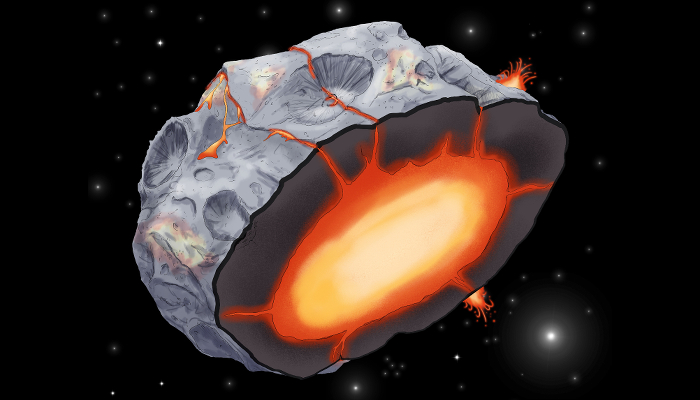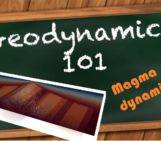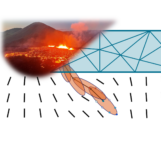
This week, Francis Nimmo, professor in the Department of Earth and Planetary Sciences (University of California Santa Cruz), tells us about volcanism on metallic asteroids! Around and after the formation of the solar system (4.5 billion years ago onwards), volcanoes on some of the gigantic bodies of the asteroid belt might have erupted … iron. Explanations.
One way in which we can learn about the insides of planetary bodies is by looking for signs of volcanism. Volcanism transports molten material from the interior to the surface of a body, where it solidifies. Something similar may happen on icy bodies, where cryovolcanism is thought to occur. Together with Coby Abrahams, one of my grad students, I recently wrote a paper proposing “ferrovolcanism”, which is the eruption of metallic iron. We suggested that this may have happened in the past on metallic asteroids.
What are metallic asteroids? Some asteroids, such as 16 Psyche are thought to be made mainly of iron and nickel, on the basis of their spectra and radar signatures. They probably originated from a catastrophic collision. The picture is that a proto-planet, which had already formed a dense metallic core, was broken apart so violently that its core was fragmented, and the fragments then cooled to form free-floating metallic bodies. Such an event would also explain the large number of iron meteorites in our collections. So far we have never seen a metallic asteroid up close, but NASA is planning to send an orbiter which will reach 16 Psyche in 2026.
How would “ferrovolcanism” work? Immediately before the catastrophic collision, the core would have been liquid (because the silicate mantle is a good insulator). After the collision, the surface of a free-floating iron blob would have initially cooled very rapidly. Analysis of iron meteorites tells us that, in some cases, the blob developed a strong, cold iron crust. The melt (liquid iron) beneath the crust would have been less dense than the crust – just like molten magma on Earth. And so, just like magma on Earth, the liquid iron would tend to rise to the surface – hence ferrovolcanism.
There are a few factors that make ferrovolcanism less likely than silicate volcanism. One is that, as the iron crust cools, it contracts, putting the whole body into compression and making it more difficult for melt-filled fractures to open up. Another is that iron is both ductile and strong, so that fracture propagation is harder. And iron is also much more thermally conductive than rock, so that melt-filled fractures will cool and solidify rapidly. Nonetheless, we don’t think any of these factors is fatal. For instance, Mercury also experiences global compression but still shows signs of volcanism. Iron eruptions might be aided by volatiles coming out of solution, just as with terrestrial eruptions, although the catastrophic impact may have removed some volatiles.
How do we test this hypothesis? One way is to wait for images of 16 Psyche! If we see things that look like iron volcanoes, that would be interesting. But identifying signs of ancient volcanism is notoriously hard – this paper documents several proposed volcanic or cryovolcanic features which turned out to be something else on further investigation. And our calculations show that the volume of erupted material will be only about 0.1 percent of the total volume of Psyche, so these features may be hard to spot – especially after 4 billion years of erosion by impacts.
Another way is to look at the iron meteorites in our collections, because ferrovolcanism should produce anomalous-looking meteorites. For instance, one might find vesicle-rich samples, or ones happening late in the crystallization sequence but showing extremely rapid cooling (because they were erupted to the surface).
How did we write the paper? It was more or less accidental. Coby was working on how iron asteroids might lose their volatiles early when one day he turned to me and said “I think they’ll erupt!”. I thought this was a neat idea, and so we started to look at how the eruptive process might work.
The strangest part of writing our paper was that at the LPSC conference someone came up to me and said “I just invented iron volcanism!”. It turned out that another group had been working on ferrovolcanism completely independently. They suggested that pallasite meteorites might be evidence of ferrovolcanism (something that I had completely missed). This simultaneous but independent development of ideas seems to be quite common in the Earth Sciences – but that is a topic for another day.







Ernest John Stockham
You can see magnetic finger prints on a crater sites impact where whatever hit Jupiter spun and would appear to have bounced off the planet couldn’t of gone to far one would think, judging of how strong the spinning magnetic astroid was, could be one of Jupiter’s moon’s maybe even ours who no,s but the Meraindia crater is interesting from Juno pictures